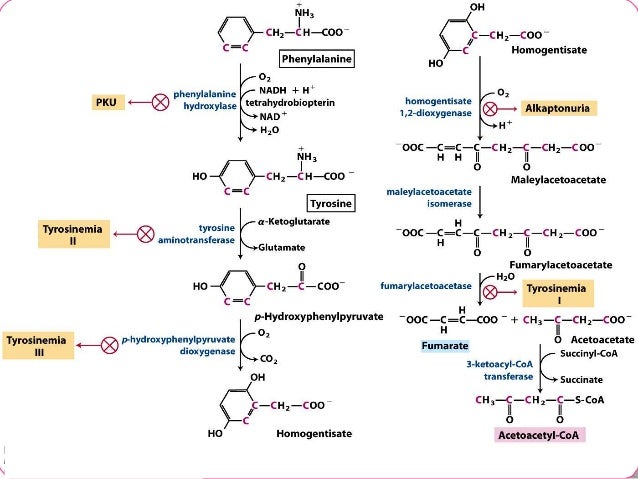Metabolism of Phenylalanine and Tyrosine and MCQs for GPAT, NEET, UPSC, SSC,GATE and Recruitment exams
Phenylalanine and Tyrosine are aromatic amino acid. Phenylalanine is nutritionally important amino acid but tyrosine is not, that is tyrosine can be synthesized in the body from phenylalanine.
Catabolism of phenylalanine and tyrosine
Metabolism of phenylalanine is initiated by its oxidation to tyrosine. Tyrosine then undergoes oxidative degradation. Thus, both the amino acid have same catabolic pathway:-
- In the first step, it is hydroxylation of phenylalanine to tyrosine this reaction is catalyzes by phenylalanine hydroxylase. This enzyme is also known as monooxygenase, because one atom of O2 is found in the product while the other atom in found in water. This enzyme requires tetrahydrobiopterin as a cofactor.
- Transamination of tyrosine with alpha-ketoglutarate to form P-hydroxyphenyl pyruvate.
- P-hydroxyphenyl pyruvate than reacts with O2 to form homogentisate. The enzyme which catalyzes this reaction is also known as dioxygenase because both the atom of O2 appears in the product
- Homogentisate that breaks its bond from O2 and yields 4-maleyl-acetoacetate. The enzyme used is also dioxygenase enzyme.
- Isomerization of 4-melyl-acetoacetate to form 4-fumaryl-acetoacetate. This reaction is catalyzed by melylacetoacetate isomerase. This enzyme uses glutathione as cofactor
- Lastly, the 4-fumeryl-acetoacetate is hydrolyzed to fumerate (glucogenic intermediate)and acetoacetate (ketogenic intermediate). Thus phenylalanine and tyrosine are both glucogenic as well as ketogenic.

Biosynthesis of some of the important compounds derived from Tyrosine: Tyrosine works as a precursor for following compounds:
- Catecholamines
- Dopamine
- Epinephrine
- Nor-epinephrine
- Melanin pigment
- Thyroxine
Biosynthesis of catecholamines:-
- Epinephrine, nor-epinephrine and dopamine are collectively known as catecholamines.
- Epinephrine and nor-epinephrine are produced by adrenal medulla and are hormones; while dopamine and products of nor-epinephrine works as neurotransmitter.
Biosynthesis of Melanin pigment
Melanin is a pigment and is produced only in melanin producing cells known as melanocytes.

Biosynthesis of T3and T4
The T3 and T4 hormones are produced in the follicle cells of thyroid gland. These are produced by the iodination of tyrosine residue of a protein known as thyroglobulin.
Multiple choice questions (MCQs)
1. Which of the following is aromatic amino acid?
A. Valine
B. Phenylalanine
C. Tyrosine
D. Both B and C
2. Why phenylalanine and tyrosine have same catabolic pathway? A. Phenylalanine is oxidative product of tyrosine
B. Tyrosine is oxidative product of phenylalanine
C. Both
D. None
3. Which of the following is the example of essential amino acid?
A. Isoleucine
B. Cysteine
c. Phenylalanine
D. All of the above
4. Which of the following is the example of non-essential amino acid?
A. Arginine
B. Tyrosine
c. Phenylalanine
D. All of the above
5. Why phenylalanine hydroxylase is known as monooxygenase enzyme?
A. One atom is found in product and other in H2O2
B. One atom is found in product and other in H2O
C. One atom is found in reactant and other in H2O2
D. Because oxygen is divalent
6. Match the following enzymes and its product-
a. Tyrosine transaminase 1. DOPA
b. Dopamine beta-hydroxylase 2. epinephrine
c. Methyl transferase 3. Nor-epinephrine
d. Tyrosine hydroxylase 4. P-hydroxyphenyl pyruvate
7. Which of the following enzyme require glutathione as co—factor? A. Tyrosinase
B. Maleyl-acetoacetate isomerase
C. Phenylalanine hydroxylase
D. none of the above
8. Which of the following are biosynthesized from tyrosine?
A. Melanin
B. Adrenaline
C. Dopamine
D. All of the above
9. Why homogentisate oxidase is known as dioxygenase enzyme?
A. 2 atom are found in product
B. 2 atom are found in H2O2
C. Both
D. None
10. Where is melanin pigment produced?
A. Keratinocytes B. Melanocytes
C. Monocytes D. Chief cells
11. Which of the following enzyme require copper as co—factor?
A. Tyrosinase
B. Maleyl-acetoacetate isomerase
C. Phenylalanine hydroxylase
D. None of the above
12. Dopaquinone is an intermediate for which pathway?
A. Synthesis of thyroxine
B. Synthesis of melanin
C. Synthesis of tyrosine
D. Synthesis of epinephrine
13. T3 and T4 hormones are produced in which cell?
A. Monocytes
B. Keratinocytes
C. Fibrinogens
D. None of the above
14. Which of the following enzyme require tetrahydrobiopterin as co—factor?
A. Tyrosinase
B. Maleyl-acetoacetate isomerase
C. Phenylalanine hydroxylase
D. None of the above
15. tyrosine residue of which protein produces T3 and T4 hormone? A. Myoglobin
B. Hemoglobin
C. Thyroglobulin
D. Apolipoprotein
ANSWERS:-
1. Both B and C
2. Tyrosine is oxidative product of phenylalanine
3. Phenylalanine
4. Tyrosine
5. One atom is found in product and other in H20
6. a – 4 b – 3 c – 2 d – 1
7. Tyrosine is oxidative product of phenylalanine
8. All of the above
9. 2 atom are found in product
10. Melanocytes 11. thyrosinase
12. Synthesis of melanin
13. None of the above
14. Phenylalanine hydroxylase
15. Thyroglobulin
Participate in Online FREE GPAT TEST: CLICK HERE
Participate in Online FREE Pharmacist TEST: CLICK HERE
Participate in Online FREE Drug Inspector TEST: CLICK HERE
Participate in CSIR NET JRF Mock Test
REFERENCE:- Pankaja Naik- Biochemistry; 4th edition; page no:-279-281